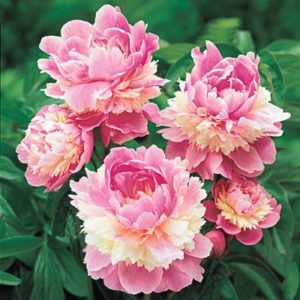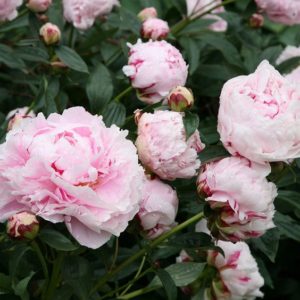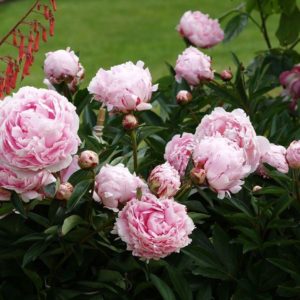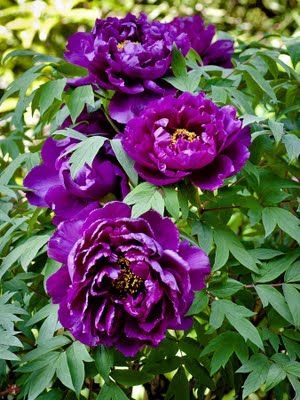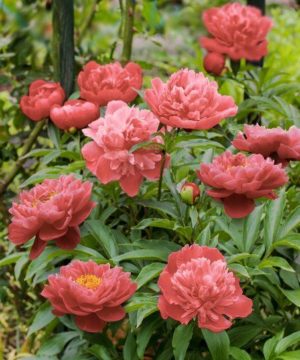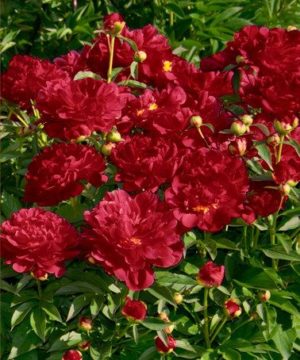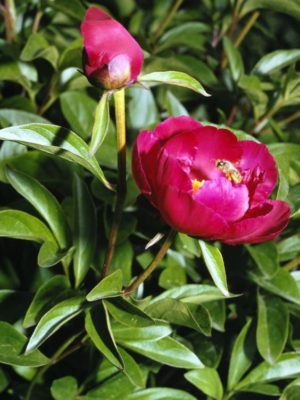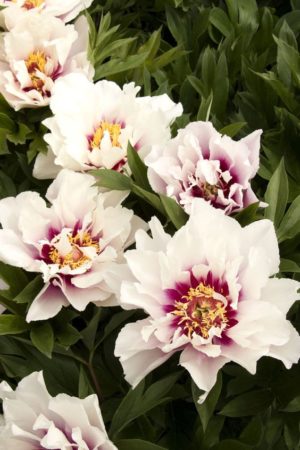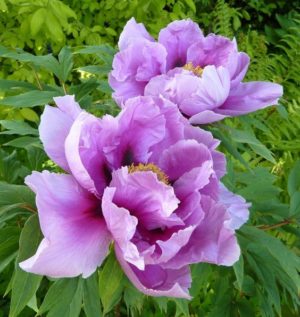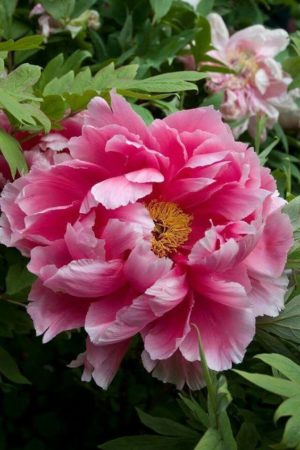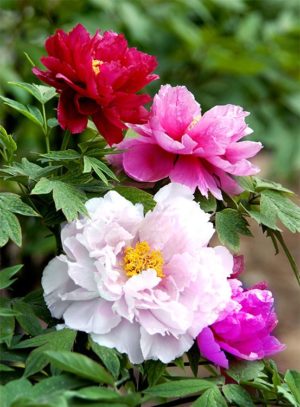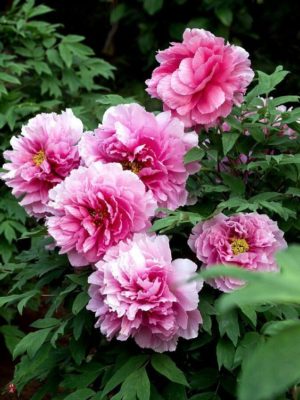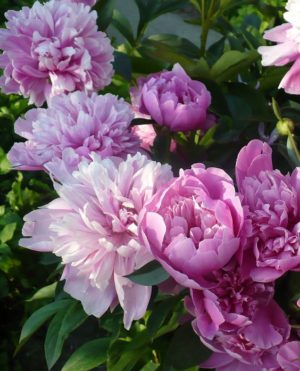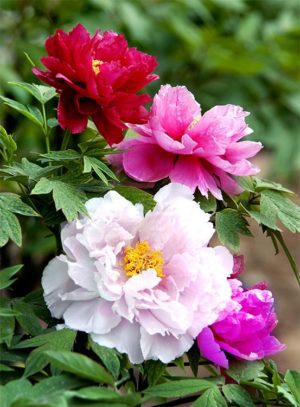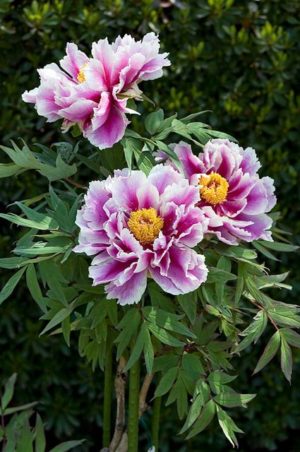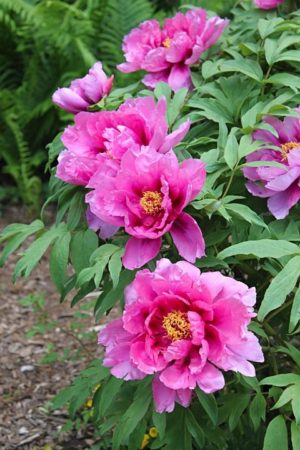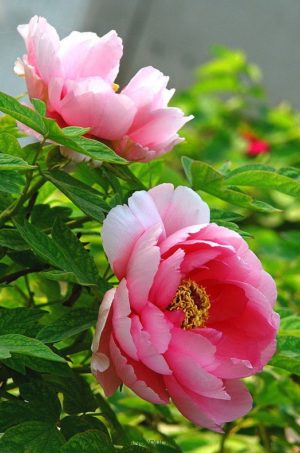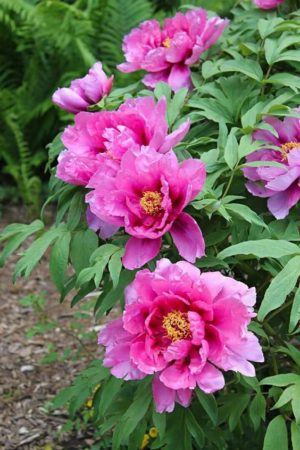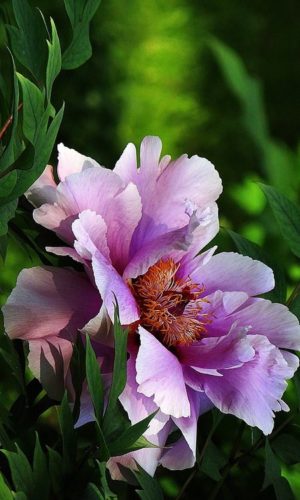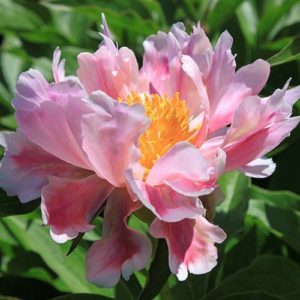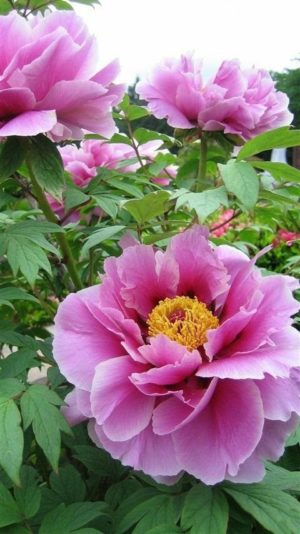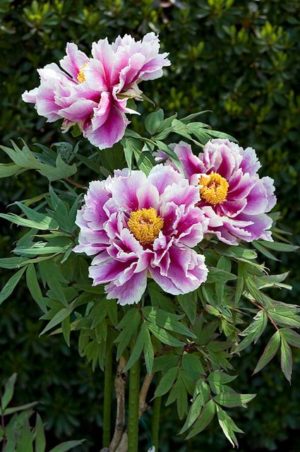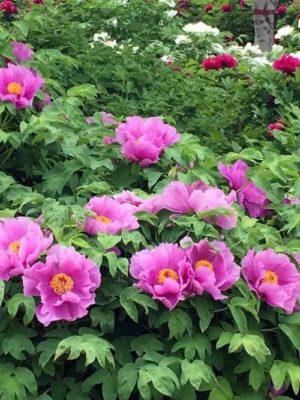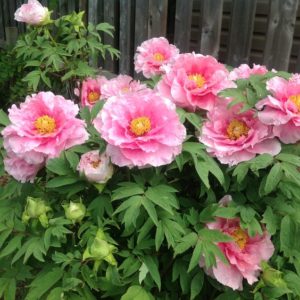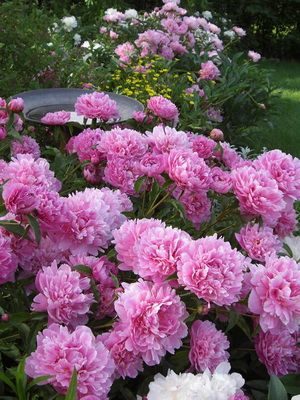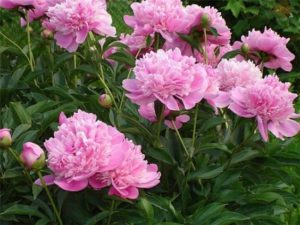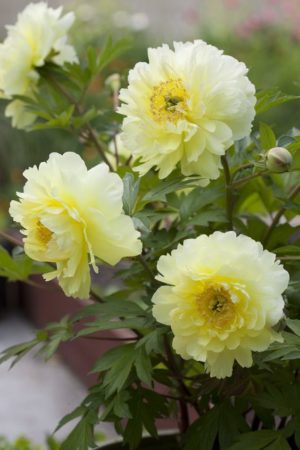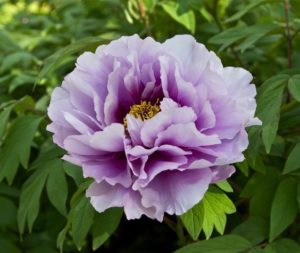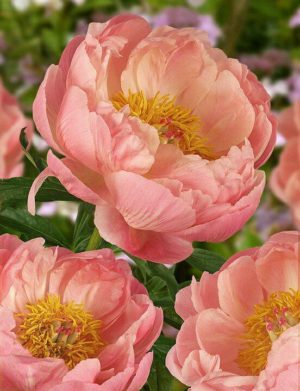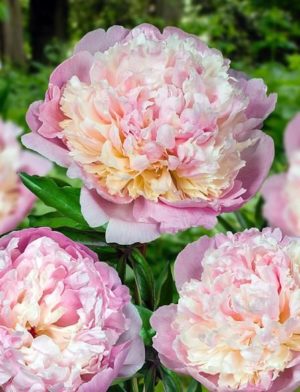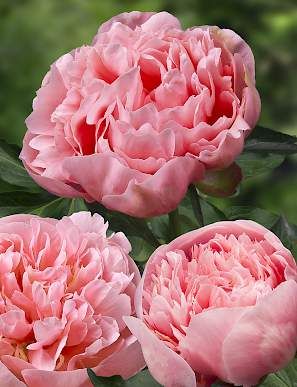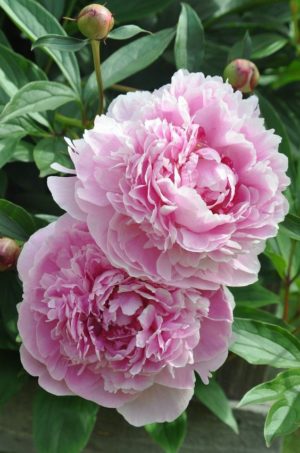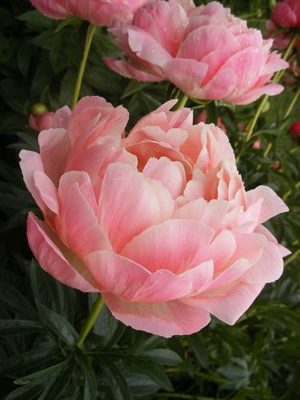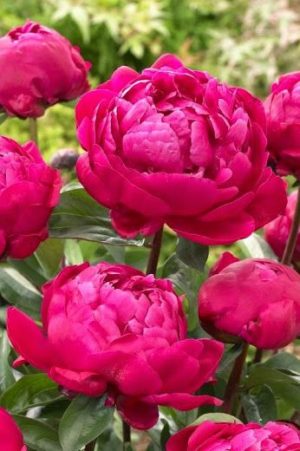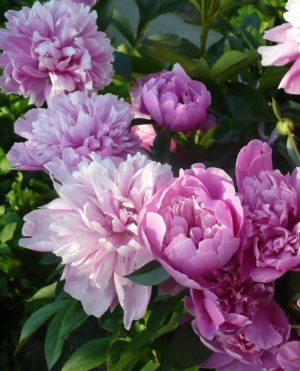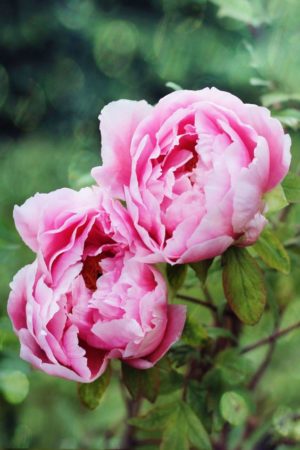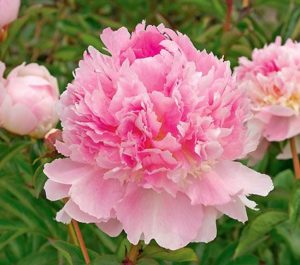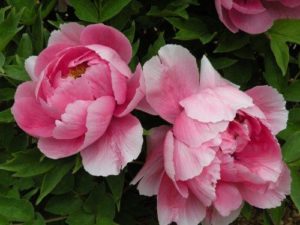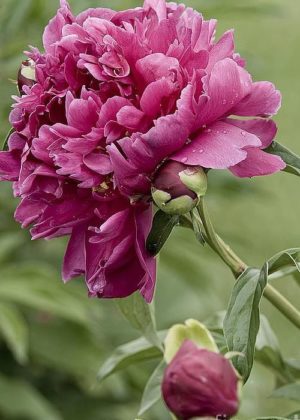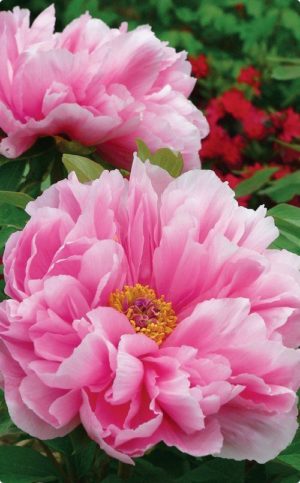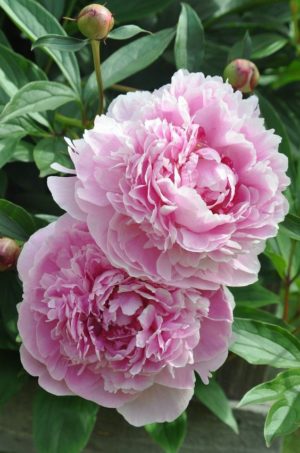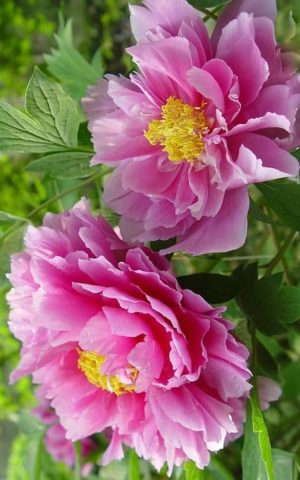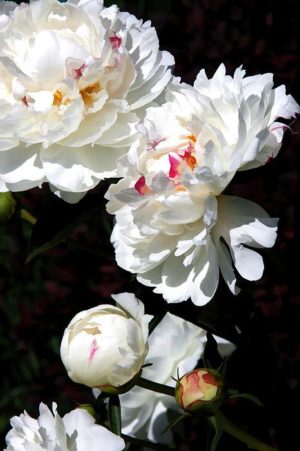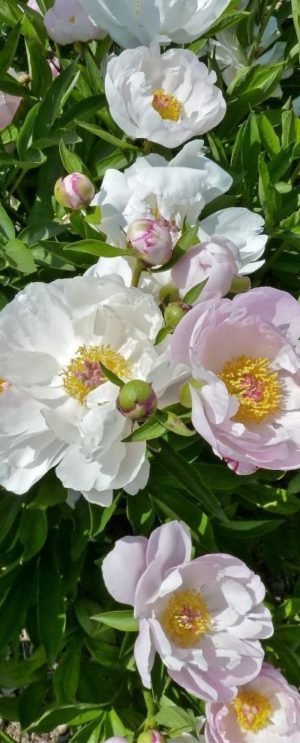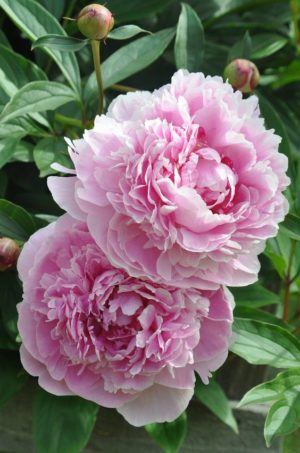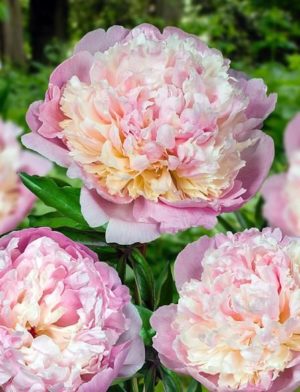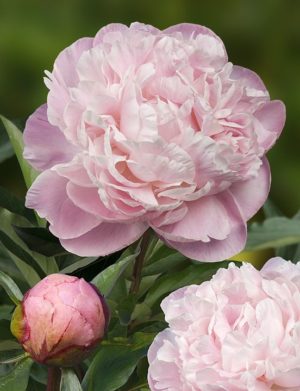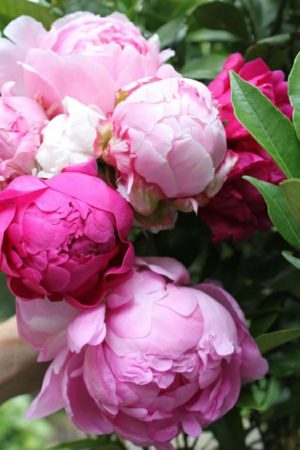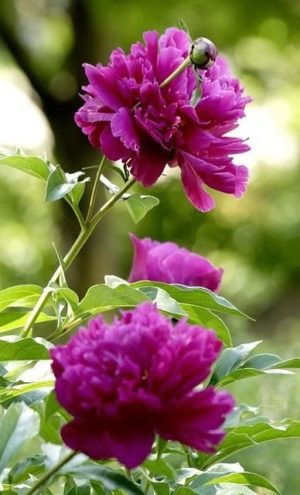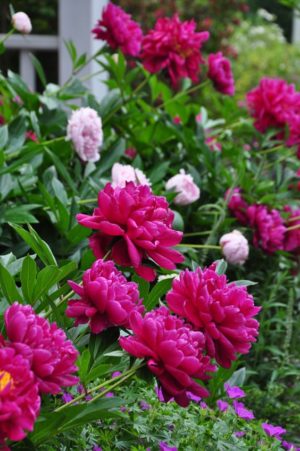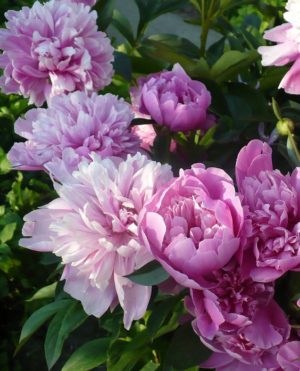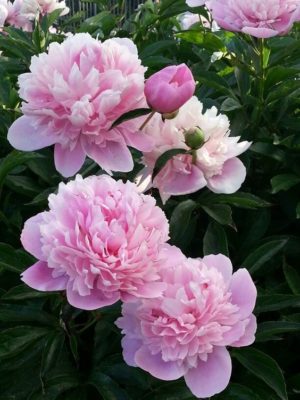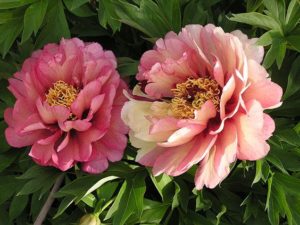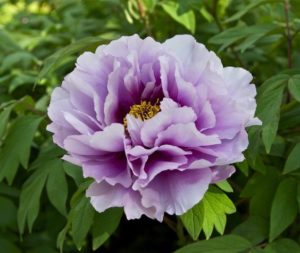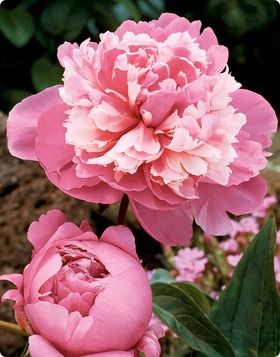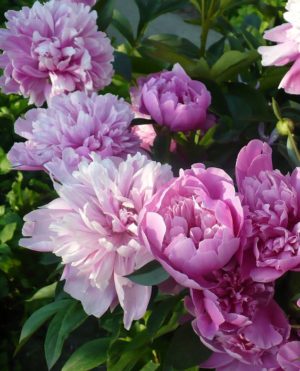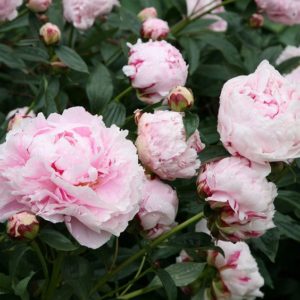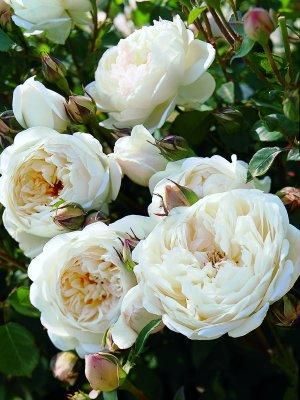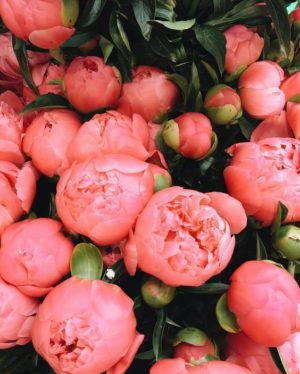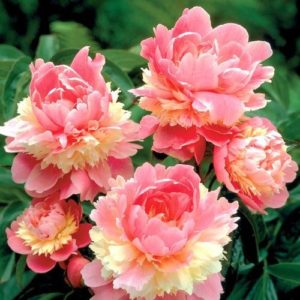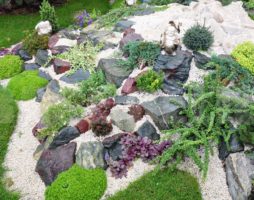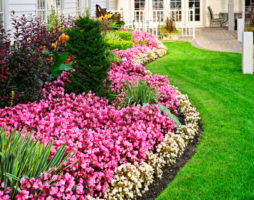Since time immemorial, people have rightfully considered peonies to be one of the best decorations for landscape design. This beautiful flower with a pronounced sweet aroma was highly valued in Ancient Greece and Rome. Many gardeners, wanting to arrange a plot, are interested in how to plant peonies and care for these plants. It is noteworthy that this representative of the flora, which has an undeniable charm, is an unpretentious plant that every gardener can grow.
- Peony from ancient times to the present day
- Types and varieties of plants
- The main types of herbaceous peonies
- Variety of tree peonies
- The main principles of correct landing
- Landing area selection
- The composition of the soil, its preparation
- Stages of the landing process
- The specifics of planting a tree plant
- Moisturizing and mulching the soil
- Plant nutrition
- peonies pruning
- Peonies from seeds
- Growing peonies at home
- Peonies in home design
- Photo gallery - photo peonies
- Video
Peony from ancient times to the present day
There is an ancient legend about the origin of this popular flower. The Greek gods loved battles, did not deny themselves the pleasure of arranging a bloody battle. Peon was engaged in the treatment of celestials. He successfully healed the Gods, including Ares himself. The god of healing envied the successful healer, Asclepius decided to poison Peon. But he managed to find out about the treacherous plan. The doctor turned to the Gods with a request for help. They turned it into a luxurious flower.
For centuries, this plant has been most valued not for its beauty, but for its healing properties. Peonies were grown and harvested by healers. The warriors of Ancient Rome, going on a military campaign, always took a peony root with them. Healers prepared an alcoholic extract from this part of the plant, relieving diseases of the liver, stomach, and kidneys. The seeds were soaked in wine to obtain a remedy that relieves restless sleep and nightmares. And in England, peonies were planted in the front garden near the house to protect themselves from dark forces. In Russia, the Caucasian variety was used for practical purposes. It was the raw material for the production of paint. Peony seeds were considered an excellent seasoning for meat dishes, and its rhizomes were added to vegetable dishes.
Particular attention was paid to the flower in China. In the 16th century, a catalog of peonies existed in this country. It included over three dozen varieties. It was the Celestial Empire that became the main source of peonies. Flowers were incredibly expensive, they were purchased for royalty, royalty, nobles, became decorations for estates and castles. Europeans brought the plant to America.

Peonies are very popular with gardeners.
Wild peonies have several habitats. All of them are located in the Northern Hemisphere. Plant thickets can be found in Europe and Asia, in the USA, Canada. In our country, peonies grow:
- in the Caucasus region;
- in Siberia;
- in the Far East.
Due to the undemanding nature of plants, the simple care of peonies, these flowers are very popular with gardeners in many countries.
back to index ↑Types and varieties of plants
All peonies are divided into 2 types: herbaceous and tree-like. In total, there are several thousand varieties of cultivated plants. They differ in the structure and size of the buds, shades, period, duration of flowering. The structure of these representatives of the flora is identical:
- multi-stemmed bush;
- root system with kidneys;
- leaves of complex configuration, arranged alternately on the stem.

tree peony
The care and cultivation of peonies of different varieties also do not have significant differences. In herbaceous species, the stems die off by winter, in the spring a new aerial part grows from the root buds of rhizomes. In shrub peonies, the stems remain to winter.
One of the advantages of this plant is an extensive range of shades. Breeders are constantly developing new varieties, the range of colors and bud shapes is constantly expanding. This allows you to perfectly match peonies for a particular landscape design.

The range of peony varieties is constantly expanding.
Numerous photos of peonies allow you to appreciate the variety of these luxurious flowers. There are plants with simple, semi-double and double buds, small representatives of 30 cm in height and full-fledged shrubs. There are detailed instructions on the Internet on how to grow peonies from seeds, properly plant rhizomes, etc.
back to index ↑The main types of herbaceous peonies
The main shades of peony are white and various shades of red, from light pink to dark burgundy. Breeders managed to breed a plant with yellow buds. Such species do not occur in nature. The flowering period of the plant is not too long. But thanks to the large number of stems, the complex shape of the leaves, even without buds, it can adequately decorate the landscape.
The most common representatives of the herbaceous species are peonies:
- lactiflora;
- thin-sheeted;
- medicinal;
- Maryin root;
- Vitman.
Milky-flowered wild flowers became the progenitors of most cultivars. To obtain new species, breeders crossed them with medicinal peonies. Plants during the flowering period are covered with lush buds with white petals. The middle of the flower is open, large golden stamens are visible.

milky peony
In thin-leaved varieties, the buds can have different shades of red, which can be seen in the photo of peonies on the Internet. The most common variety is Divine Sarah. A plant with delicate pink terry buds, intense aroma was bred in honor of Sarah Bernhardt at the beginning of the last century. Medicinal varieties differ in the color of red ruby, Maryin root has dark purple buds. The flowers of Wittmann's peonies are white-yellow in color.
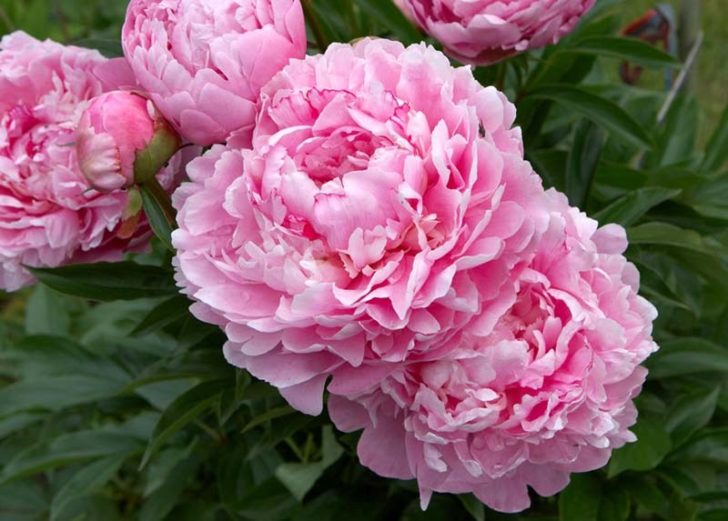
Terry buds varieties Divine Sarah
Those who want to know how to grow peonies in the country, which will delight the eye with lush buds for a long time, should choose several varieties of plants that differ in the period and duration of flowering. These representatives of the flora can bloom in May, June. It depends not only on the variety, but also on the climatic conditions of the region.
back to index ↑Variety of tree peonies
Many summer residents and owners of suburban areas are now interested in the rules for planting and caring for tree peonies. Relatively recently, these plants began to be used in landscape design in our country. The highest popularity of these species is observed in Japan, China.
A bush of a tree-like peony can reach a height of two meters. In landscape design, varieties are mostly used:
- European-Chinese terry;
- Japanese terry, semi-double;
- hybrid.
Terry peonies, bred by European, Chinese breeders, have an extensive color palette. Shrubs during the flowering period are covered with large buds with a huge number of petals. Each flower has a solid diameter, and therefore a lot of weight.The branch cannot withstand such a load; supports are required.
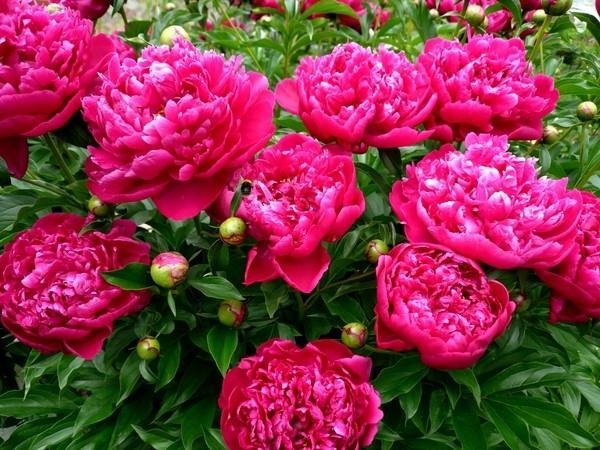
Terry peonies are distinguished by a huge number of petals
Increasingly, flower growers are interested in the rules for the care and cultivation of tree peonies of Japanese varieties. In this category there are terry and semi-double types, the color range is widely represented. Unlike European, Chinese counterparts, the buds are light in weight. The shrub does not need props.
The main attraction of hybrid plants is the yellow color, uncharacteristic of peonies. Bushes perfectly decorate the garden, not only during flowering, thanks to openwork foliage, splendor. In their production, herbaceous and shrubby varieties were crossed. In the form of foliage, the plant repeats tree-like varieties. But the stems die off by winter, like herbaceous varieties. The rules for planting Ito hybrid peonies and caring for them are identical to the recommendations provided for other species.

Ito peonies with atypical yellow coloration
Currently, there are many varieties of shrub peonies on the market. Breeders managed to bring out several species that can survive our cold winters without loss.
back to index ↑The main principles of correct landing
It is important to learn the rules for planting peonies in the open field and caring for them if you want to make these plants worthy decorations of the site. These plants are unpretentious, they can feel great in one place for more than 10 years. But unscheduled transplants will slow down growth and development, and may cause a lack of flowering. Therefore, the place for planting the plant must be chosen carefully.
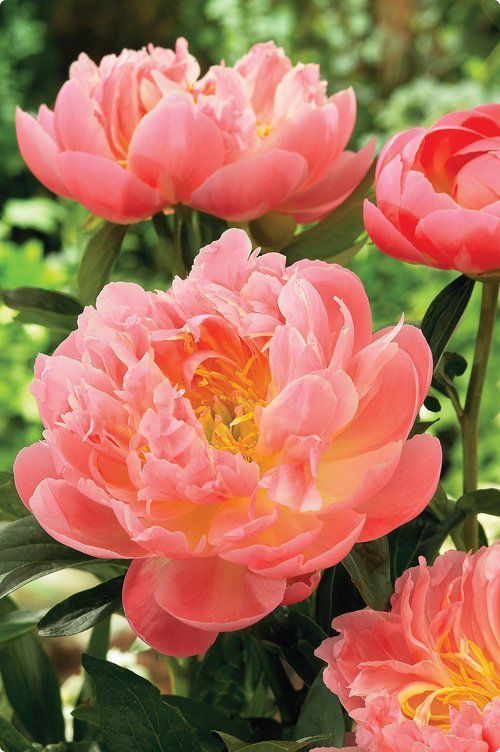
Even novice gardeners can handle growing peonies
Traditionally, peonies are propagated by seedlings with their own root system. But now some experienced flower growers are practicing growing peonies from seeds. This is a rather complicated process that requires time, attention, and patience. Planting rhizomes does not cause difficulties even for beginner gardeners.
There are four main principles in planting a peony:
- competent choice of place;
- high-quality soil preparation;
- correct placement of the rhizome;
- the optimal time for disembarkation.
The plant is not very demanding. But this does not mean that landing does not require a responsible approach. You can find the perfect place for a flower in any area, given its preferences. The peony does not need fatty black soil, but a certain preparation of the soil is necessary for the normal development of the root system, which has to not only nourish the plant, but also form new stems every year.

Peonies are not at all picky about the soil
Thanks to the emergence of new breeding varieties, the import of plants from Europe and Asia, the traditional rules for the care and planting of peonies have somewhat changed. Previously, it was recommended to plant plants only in the fall, now spring plantings can also be carried out.
back to index ↑Landing area selection
Peonies look great both during the flowering period and after it. They can be used as:
- the central element of the flower bed;
- hedge;
- zone framing, etc.
For those who want to know how to grow peonies, the first thing you need is information about the preferences of this plant. Do not plant it near the wall of the house, outbuildings. The buildings heat up, radiate heat, which the plant does not tolerate well. This flower loves the sun, it is especially important to ensure an intense supply of ultraviolet radiation in the morning. Therefore, for pions, it is desirable to allocate a zone on the eastern, southeastern side.
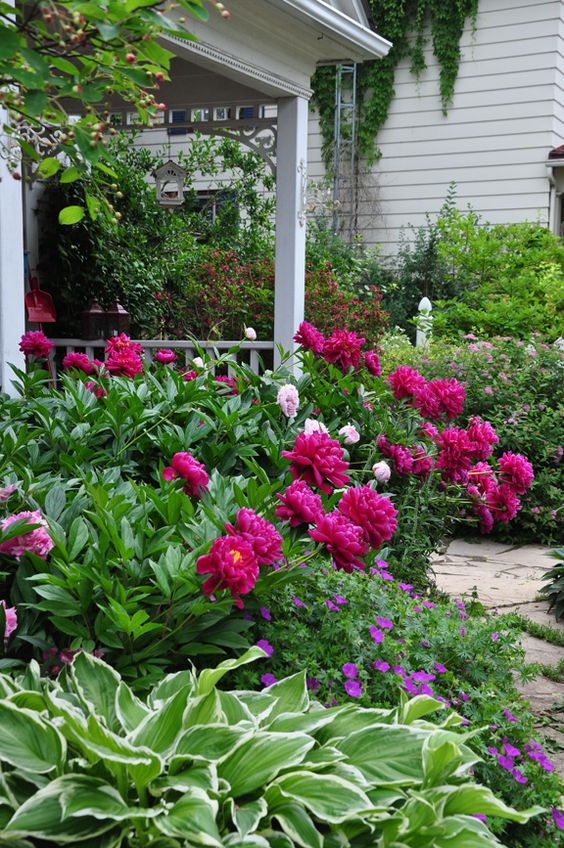
Set aside a zone for peonies on the east, southeast side
These flowers grow well in open places, allowing the bush to grow qualitatively. But winds and drafts can adversely affect growth and flowering. Protection should be created, which can be used as a large-sized or hedge, gazebo, pergola, etc.On the Internet there are instructions for placing herbaceous flowers, photos of planting tree peonies and caring for them.
Sufficient moisture supply is necessary for roots, succulent stems and leaves, buds. However, the lowland, in which moisture always accumulates, is not the best place for a peony. There is a real risk of decay processes in the rhizomes, the death of the plant.
If you plan to plant several herbaceous peonies, you must ensure a distance between plants of at least 80 centimeters. If you are interested in the care and planting of Ito hybrid peonies, tree varieties, you should consider their height, bush diameter when choosing a place.
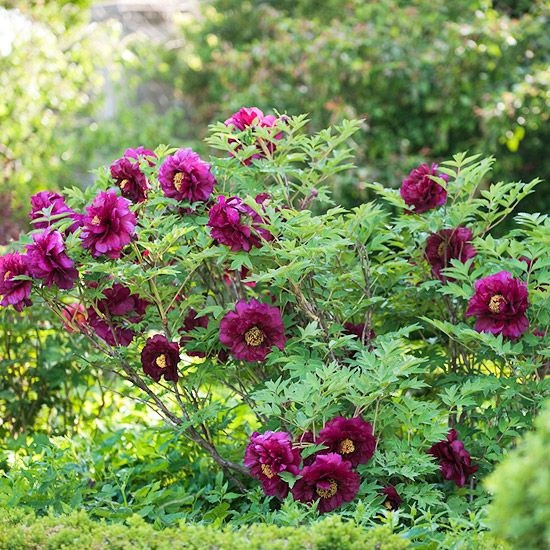
When planting tree peonies, consider their height and diameter of the bush
The composition of the soil, its preparation
In order to know how to grow peonies that will decorate the garden for many years, you need to familiarize yourself with the preferences of plants. The favorite soil for all varieties and species is loam. Moreover, these plants are suitable for soil with a slight deviation in balance, an increased content of alkaline elements. The clay component can predominate in loams, which makes it heavier and complicates the supply of moisture and mineral components. In this case, mulching agents are added to the soil:
- peat,
- humus,
- sand.
If the soil structure is dominated by sand, the moisture will leave too quickly, creating a risk of drying out the roots. Clay is added to this soil, as well as humus for quality nutrition.
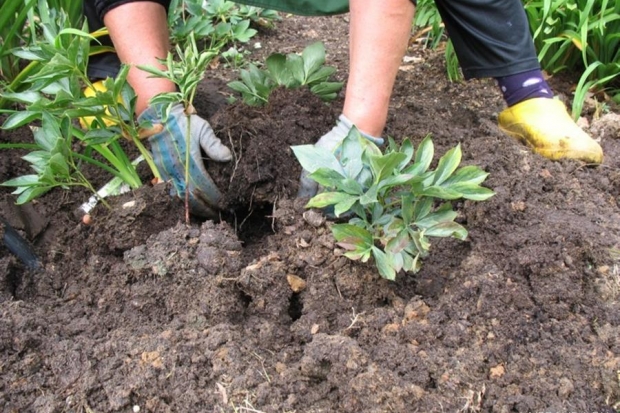
The best soil for all varieties of peonies is loam
Gardeners often have the question of how to grow peonies in the country if peat prevails on the site. This soil is not a very suitable environment for such plants. However, you can solve the problem, create normal conditions for the flower. To do this, you need to add sand, wood ash, organic mixtures to the soil.
back to index ↑Stages of the landing process
Special sites explain in detail how to plant peonies and care for these plants. Planting will not cause great difficulties, but it is necessary to take into account some nuances to create high-quality conditions for the flower:
- the pit must have the appropriate dimensions;
- a drainage layer is equipped at the bottom;
- the optimal depth of the growth point is observed.
The diameter of the hole is about 80 centimeters, its depth is about half a meter. The soil taken out of the hole is enriched with additional structures, taking into account the characteristics of the soil, as well as potassium-phosphorus fertilizers, and manure.
First, a drainage layer is laid to prevent waterlogging of the roots. In this capacity, crushed stone, expanded clay or broken brick can be used. Then the earth is poured, taking into account the height of the seedling. He gently straightens the roots, which should be directed down. The growth point cannot be buried more than 4-5 cm. Otherwise, the plant will often get sick, there may not be flowering at all.
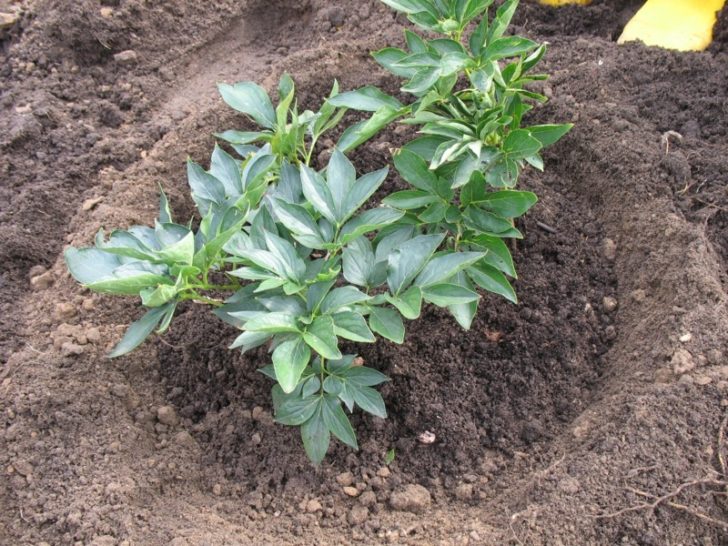
The diameter of the hole is about 80 centimeters
You can help the plant to survive the transplant easier, faster. For this, the root system is processed. A special clay-based mixture is being prepared, to which copper sulfate, heteroauxin is added. Chatter should have the consistency of thick sour cream. The peony root is dipped in it before planting. This measure will help make planting a peony less painful, and minimal care will be required.
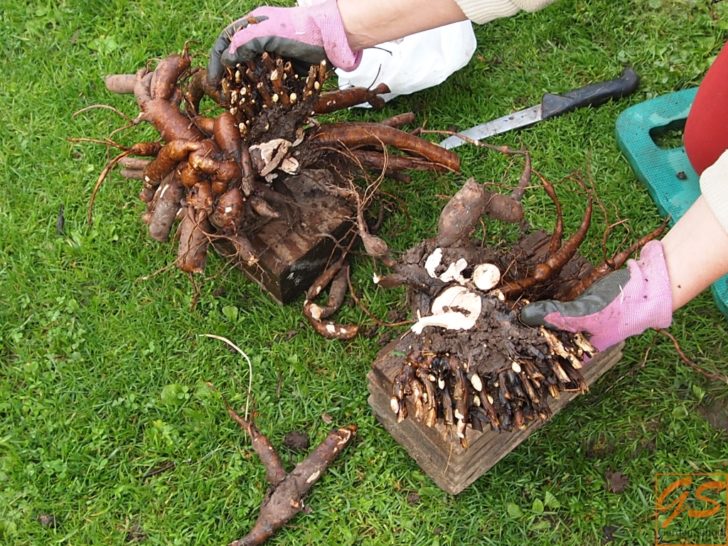
Root treatment will help survive the transplant
The final step is watering. The seedling needs about a bucket of water. After shrinkage of the soil, it must be poured. Straw or peat can be added for mulching. If you follow the rules of planting, caring for peonies will not create any difficulties. The bush will develop well and bloom violently.
back to index ↑The specifics of planting a tree plant
Planting tree peonies and caring for the plant differ little from the rules provided for herbaceous varieties.It is only necessary to take into account that these flowers can be in one place for up to half a century. The place for such an element of the landscape should be chosen very carefully. Do not forget about the dimensions of the bush.
When landing, the following rules are taken into account:
- between bushes, between a peony and a wall, a large-sized distance should be about one and a half meters;
- the pit for the seedling is about a meter in diameter, 70-80 cm deep;
- it is desirable to plant a plant in early September.
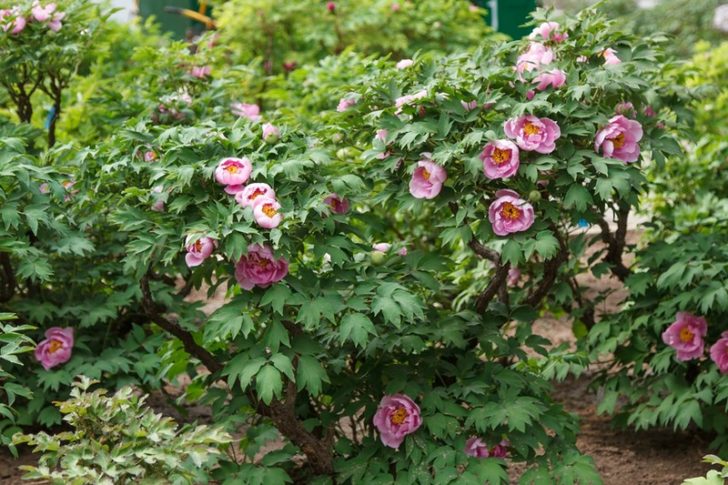
Tree peonies can be in one place up to half a century.
On step-by-step photos of planting tree-like peonies and caring for them, you can study the features of the procedures.
back to index ↑Moisturizing and mulching the soil
Not only planting, but also care, growing peonies is not a difficult task that requires special skills. These plants have few requirements. They are needed periodically:
- water,
- loosen,
- feed
- protect against pests and diseases.
We should not forget that in the first half of the day the flower needs intense sunlight. If the bushes located next to it, growing, create a thick shadow, they need to be cut off in a timely manner.
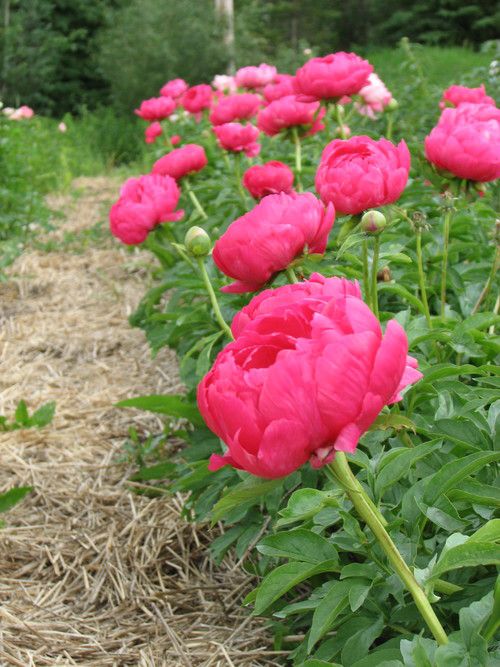
Peonies need intense sunlight
In the spring, in the first summer month, the peony needs abundant watering if the weather is dry. Every 10 days you need to pour 2 buckets of water per 1 sq.m. This promotes the formation of buds on the rhizomes. During the flowering period, after it, peonies can be watered no more than once every 2 weeks. For 1 sq. m requires about 4 buckets of water. Deep loosening is not necessary, this can damage the root system.
back to index ↑Plant nutrition
Growing peonies in the first year after planting does not include top dressing. The soil has enough nutrients if it has been properly prepared. In addition, in this period, the process of assimilation of mineral compounds is slowed down. For better development, it is possible to use funds for extra-feed top dressing: Baikal-M, Kemira. Nutrient spraying is carried out in April. For this, Agricola's solution is used. At the beginning of summer, this procedure is carried out using Ideal.
Older plants need to be fed regularly. Peony care begins in the spring. During the period of leaf blooming, it is necessary to close up compost or humus in the soil near the bush. Nitrogen compounds are used for root dressing. During the formation of buds, it is necessary to water the soil with cow dung infusion, to which nitrophoska must be added. Wood ash is added to the soil at the roots. It is advisable to spray the bush with a special tool Bud.
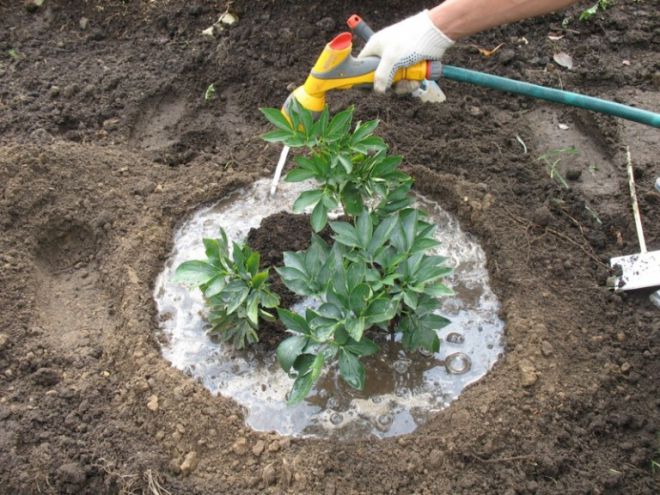
Root top dressing of peonies
Gardeners who plant pions, care in the open field, should be aware of the main enemies of the plant, methods of struggle. These include gray mold and powdery mildew. Provoke the appearance of botrytis can:
- heavy rains;
- excess nitrogen in the soil;
- not enough space for the plant.
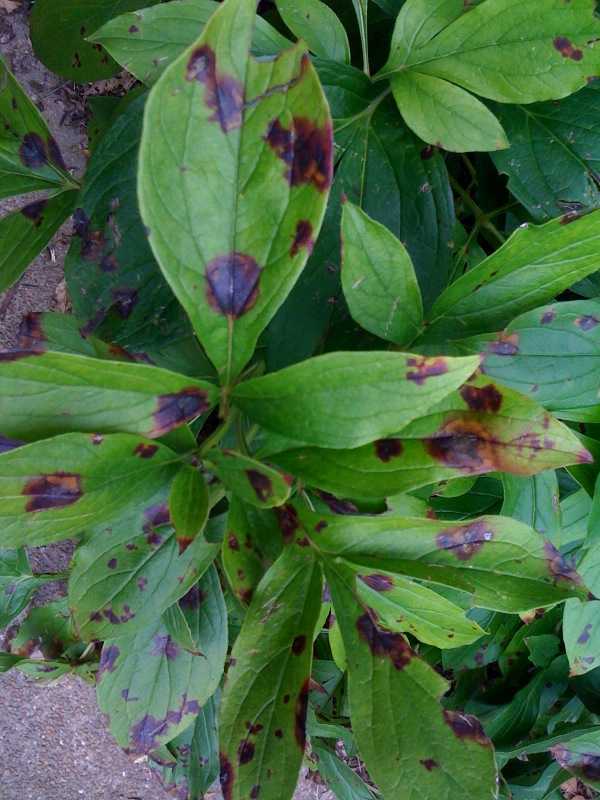
Signs of peony botrytis disease
You can get rid of gray rot with an infusion of garlic, copper sulfate. The affected parts of the plant are cut off and burned before processing. In the care of peonies in the spring, you need to carefully examine the stems and leaves in order to notice signs of the disease in a timely manner.
back to index ↑peonies pruning
After peonies bloom, pruning is necessary. This operation is necessary for the qualitative formation of the kidneys in the next season. It should be started two weeks after the buds wither. When pruning, a stem is left, about 15 centimeters high.
The next pruning is done in the fall. After the first frost, the aerial part of the grassy peonies is removed. The height of the cuttings should be about 10 cm. Cut stems with foliage should be burned.
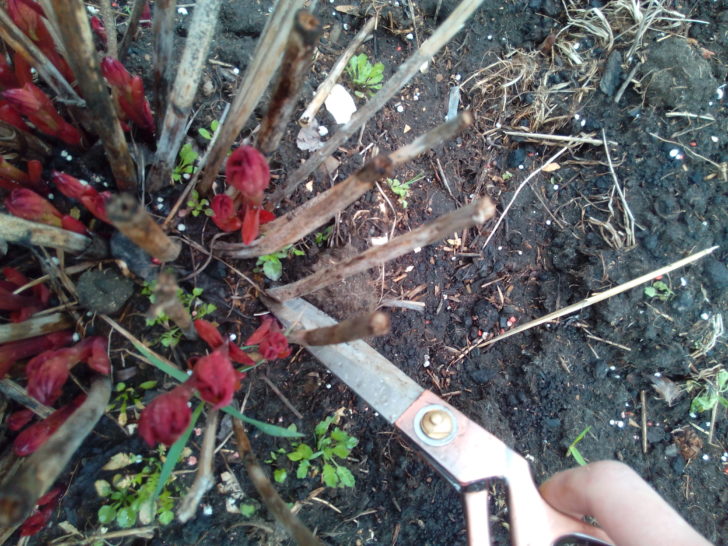
Pruning is necessary for the qualitative formation of the kidneys
There are certain specifics in the rules for the care and cultivation of tree peonies:
- Pruning of these plants is carried out in the spring.After the snow has melted, damaged, dry branches should be removed. All old stems are cut to 10 centimeters.
- If there are branches that have suffered from frost, they are cut to the first living bud.
- Every 10 years, the bush rejuvenates, all shoots are cut off.
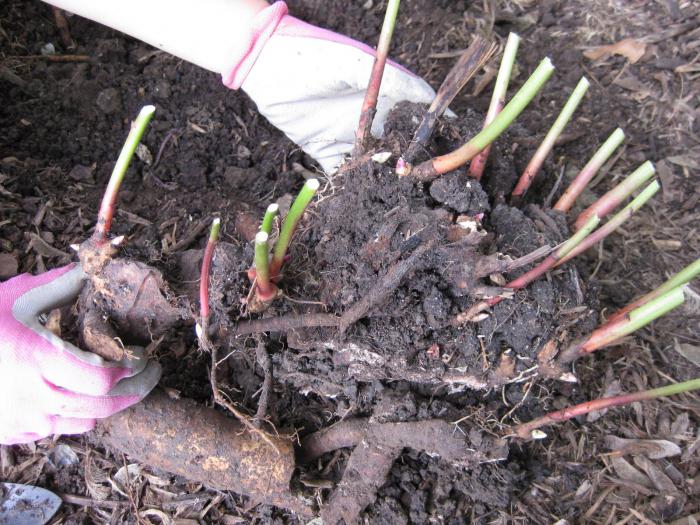
Every 10 years all shoots are pruned
Peonies from seeds
The desire to learn how to grow peonies from seeds appears among gardeners who want to acquire plants of rare varieties. Such flowers cannot be found at the neighbors in the country, in the store, in the market. This method is also used for plant propagation. But you need to consider that this process has a certain complexity, it will require patience and time.
Growing peonies from seeds is not very popular, because:
- before the appearance of flowers on the plant, you have to wait at least five years;
- in the process of growing, it is necessary to follow all the rules in order to get the expected result;
- properties of the plant are not always preserved.
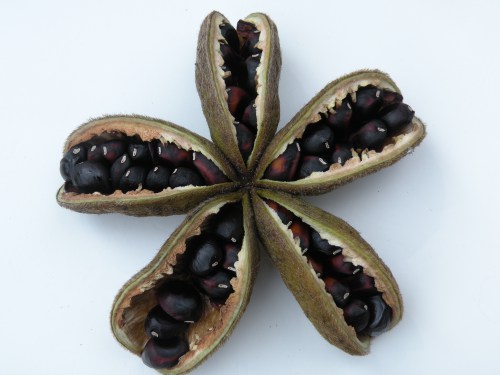
Growing peonies from seed takes patience and time.
In growing peonies from seeds, pre-dried and fresh fruits can be used. You can collect them from August 20 to September 15. This will create ideal conditions for germination. Seeds are immediately planted in the ground. The depth of the hole is 5 cm. Some seeds will sprout in April. It is possible that shoots will appear next year.
back to index ↑Growing peonies at home
Many gardeners practice growing peonies at home. The germination process usually takes about two months. The following procedures must be followed:
- for seeds, prepare a substrate in a ratio of 1: 3;
- put the seed material in a strong solution of potassium permanganate for ½ day;
- steam the substrate with boiling water;
- Pour the mixture once a week, stir, moisten if necessary.
The warm phase is followed by the cold phase. To do this, the container with seeds and substrate must be placed in the refrigerator on the bottom shelf, stored for 90 days.
If dried seeds are used in growing peonies at home, they must be soaked before being placed in the substrate. Two days they should lie in water at room temperature. After that, during the warm period, they should be in the sand, which is well moistened in the first days for swelling. The container must be placed on a radiator or electric heating pad. The warm period lasts 2 months. At this time, the seeds sprout roots.
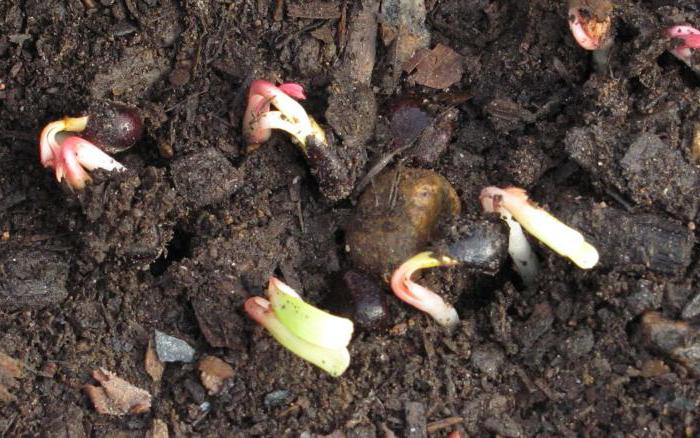
The germination process takes about 2 months.
Before the cold period, the tip of the spine must be pinched. For seeds, prepare a mixture of river sand and peat in a ratio of 1: 1. Until the first leaves appear, the container with seeds should be stored at a temperature of 10 ° C. Plants are planted in April, the depth of the hole should be about 5 cm. Flowers are transplanted to a permanent place only next year. This operation must be completed in mid-late August.
back to index ↑Peonies in home design
Everyone knows how wonderful these plants decorate the garden. But peonies look no less attractive in the interior of an apartment or a house. These representatives of the flora are intended for open ground, they need a change of cold and warm seasons. However, this does not mean that they cannot be grown at home. You just need to know how to care for peonies in such conditions.
There are several basic rules for gardeners who decide to place a peony in the interior, to make it an original accent:
- the flower does not like transplants, the pot with drainage holes in the bottom should be voluminous, about 5 liters;
- you need to plant a plant in the spring, observing the optimal depth;
- half of the flower container is covered with peat, it is necessary to add compost for nutrition, nitrogenous fertilizer;
- the plant is installed near the western, southern side of the world to provide a large amount of sunlight;
- it is necessary to install a lamp to make up for the lack of natural light;
- watering the plant is carried out when the topsoil dries up until water flows out of the drainage holes;
- fertilizers soluble in water are used in top dressing;
- at the end of August, watering and lighting are reduced to prepare for a dormant cycle;
- after trimming the above-ground part, the pot is installed in a cool place - in the garage, basement, on the loggia, etc.
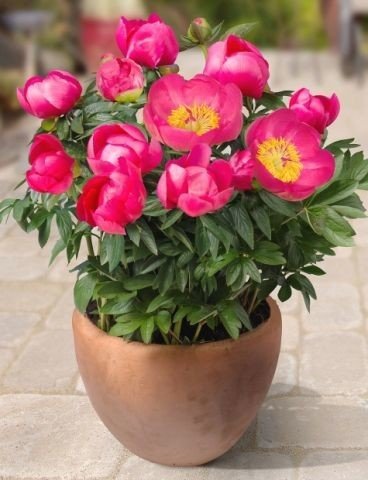
Peonies in pots will decorate any interior
If you carefully study the recommendations explaining how to care for peonies in an apartment, follow the rules for planting and caring, your favorite flower will delight you with lush foliage and lush flowering.
back to index ↑Photo gallery - photo peonies
Video
